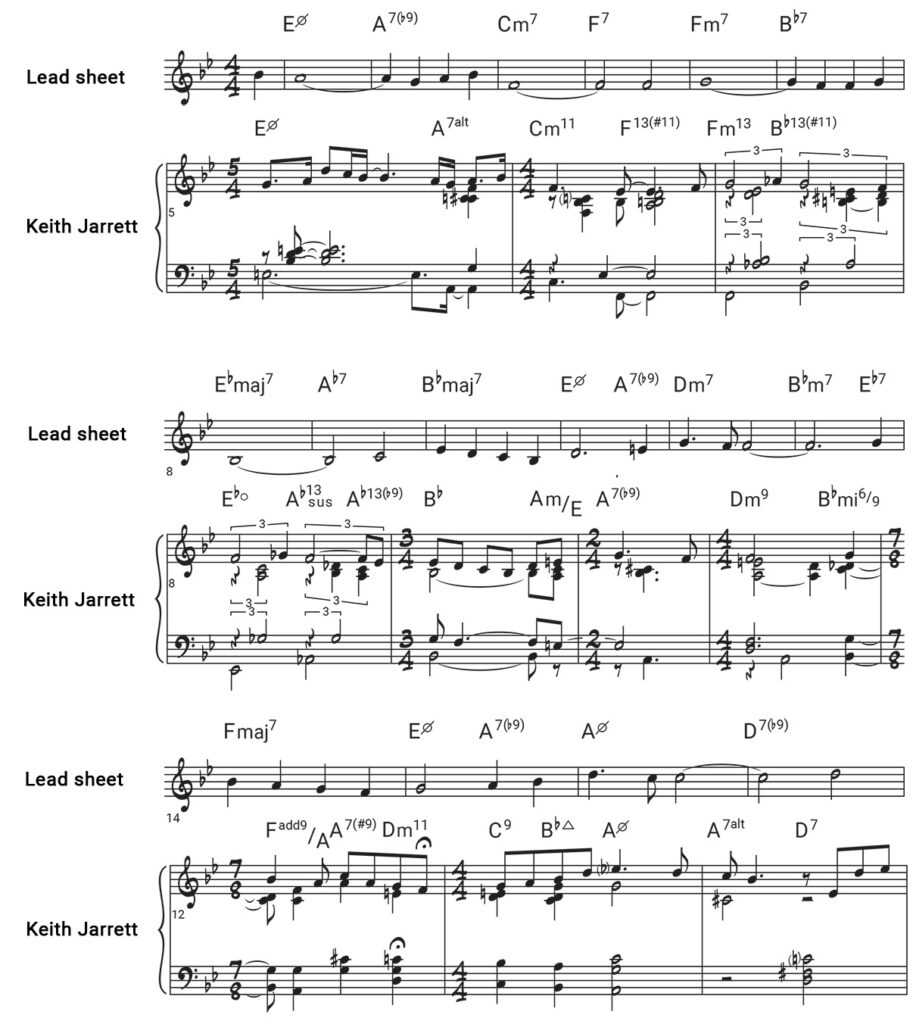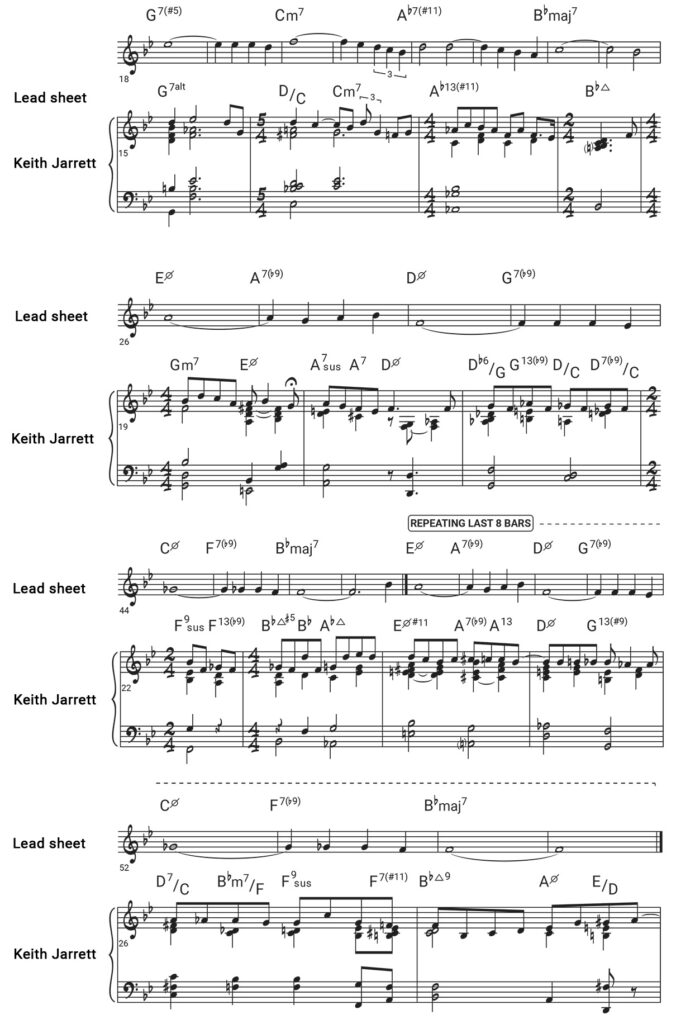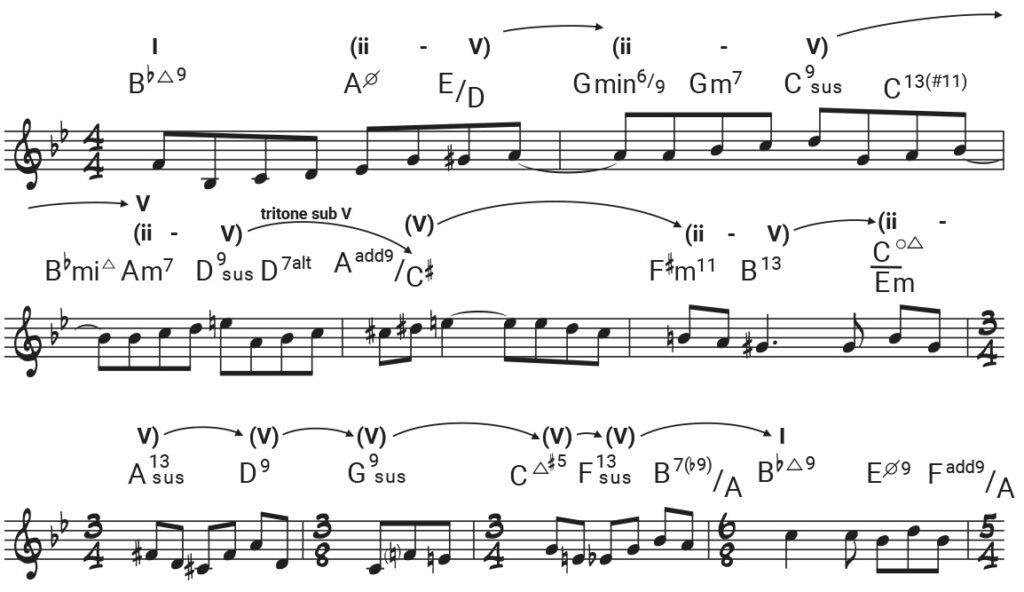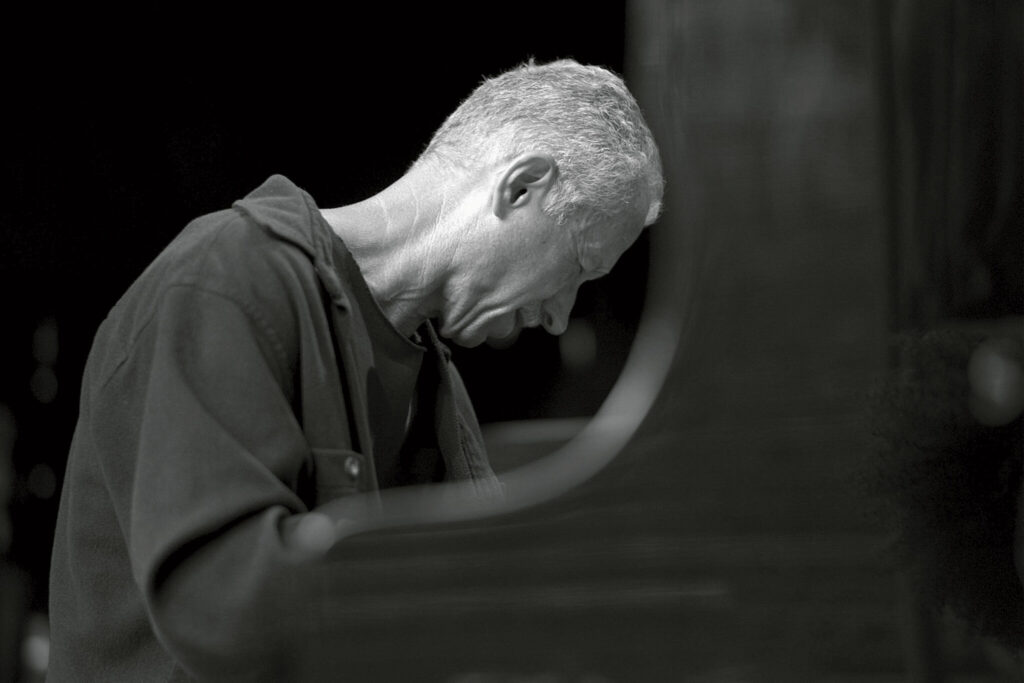In this post, I’ll be breaking down Keith Jarrett’s intro to “Stella by Starlight,” one of my favorite piano intros of all time. I’ll share my transcription and discuss the elements that make it so powerful.
The Keith Jarrett Interview
Last month, music producer and YouTuber Rick Beato released a mesmerizing interview with the great Keith Jarrett, which rekindled my love for one of my absolute favorite pianists. Jarrett suffered two strokes in 2018, which left the left side of his body paralyzed, and he hasn’t performed since. Before the stroke, Jarrett was not known to be particularly communicative, and at times he had a strained relationship with his live audiences. This interview was disarming in a way that moved me deeply — it shows a warm and candid Keith Jarrett sitting at the piano, reflecting on life and music, and even playing a few tunes with just his right hand. Highly recommend to anyone who loves Keith Jarrett:
Keith Jarrett's Intro to "Stella by Starlight"
Back in college, as an undergraduate jazz student at the Conservatory of Amsterdam, I chose Keith Jarrett’s famous piano introduction to “Stella by Starlight,” from his 1986 trio album “Standards Live,” for my final ear-training transcription (shout out to my theory teacher Walther Stuhlmacher).
This intro is breathtaking — and completely improvised. Jarrett creates instant melodies that weave in and out while ever-changing harmonies slowly move away from the original chords, building towards a climax, before returning to the original melody. This introduction lasts for more than 3 minutes, and every second of it is pure creativity and flow, with ideas shifting seamlessly from one to the next.
Have a listen:
At the time, this was the hardest thing I had ever transcribed, and it took me months to finish. Now, many years later, I look back on it and realize I made quite a few mistakes in my transcription. I spent last week re-transcribing and practicing this intro, and will share my analysis and takeaways with you.
Here’s my transcription, with the sheet music scrolling along:
At the time, what Jarrett was doing was a pure mystery to me. I loved the way it sounded, I loved the singing quality of the melodies, and I loved the moving harmonies, but I had no idea what was truly going on, even after transcribing it. Today, I have a much better understanding of its structure and development, so I’d love to share the things I’ve learned from this introduction with you. Let’s break this down into three different elements: melody, rhythm, and harmony.
Melody
In Jarrett’s introduction, the melody is central. It’s the top voice that steers the ship; everything else is in service of it. It has a singing quality that makes even Jarrett himself sing along (some people hate this habit of his, but it doesn’t bother me). Jarrett starts with a brief improvised melody that ends on an F major chord, the V-chord of “Stella by Starlight” (which is in the key of Bb). He then proceeds to loosely play through the melody and chord changes of the theme. To clarify this, I’ve added the first 16 measures of the lead sheet of “Stella by Starlight” on top of Keith Jarrett’s interpretation, so you can clearly see his melodic variations and reharmonizations:

As you can see, Jarrett roughly sticks to the melody and chord changes, but embellishes the melody and adds in some additional chords.
Here are the next 16 bars:

You can see that the melody departs even more: we can still recognize the harmonic structure of “Stella,” but Jarrett’s lines have moved on. A melodic fragment can suddenly inspire a sequence, wherein a short melody gets repeated while moving through different harmonies, like in measure 20-23:

This is all happening organically, and it can inspire a complete departure from the original form — like when Jarrett repeats the last 8 measures of the form (Eø A7 Dø G7 Cø F7 Bbmaj) as if he needs to finish his melodic thought.
Rhythm
The rhythm of Jarrett’s introduction is, again, in service of the melody. You can see that my transcription is full of meter changes and includes even odd meters such as 7/8. However, I doubt that Jarrett is thinking in terms of odd meters. These are not quite meter changes in the traditional sense, as none contains a strict pulse; this is a rubato ballad, flowing freely, not a grid wherein all the notes should fit. Sometimes a melody happens to contain 7 notes, so when writing them down, they form a measure of 7/8, but it’s really more of a loose grouping of notes, rather than a rhythmic grouping.
For example, in measures 36-40, you’ll see a repeating descending melodic line — but each line has a different length and a different number of in-between notes, causing the transcription to contain odd meters:

Harmony
As mentioned before, the first half of this piano introduction follows the chord changes of “Stella” pretty closely, albeit with tons of passing chords, reharmonizations, and substitute chords. However, after measure 27, the harmony gets detached from the original form.
When studying the harmonic structure of this “free” section, I realized that most of it can be explained by a sequence of secondary dominant chords — meaning each chord has a dominant function that resolves to the next chord, which in turn becomes a dominant chord of its own. Thus it moves through a sequence of functional chords while building melodically, finally resolving back to the original harmony at measure 47 (Eø).
I’ve written out just the top melody with chords, from measure 27 until 34, with a harmonic analysis in Roman numerals. You’ll see that each chord has a secondary dominant function (or a secondary ii – V function), indicated by an arrow:

Note that I analyzed the C9sus chord resolving to Am7 on the second line as a secondary chord resolving to the V chord (F major). In my mind, Am7 and Fmaj7 are almost interchangeable, so C7 can resolve to Am7. Think of this progression as a turnaround in F: Gm7 – C7 – Am7 – D7.
Perhaps analyzing the A#/C# as part of this secondary chord sequence is pushing it a bit (since it’s not a dominant chord). But if we treat it as a C# minor chord (which is very close to Amaj), the preceding D functions as a secondary tritone dominant to C# minor, and the bass note, C#, becomes the dominant of the next chord, F#minor.
As was the case in analyzing the rhythm, I doubt that Keith Jarrett thinks this out in a structured way. It just evolves organically, and using secondary dominants to move through different keys is a natural way to push harmonies forward.
Flow state
As a music theory buff, I love analyzing these chords and melodies, but it really doesn’t get to the heart of what makes this so powerful. In these free-flowing performances, Keith Jarrett seems to touch upon something that seems mystical to me, something sublime (and I say this as a non-religious person). There’s a oneness of body and mind, and it’s clear to me Jarrett is in a flow state wherein nothing else exists: it’s just music, speaking directly to the listener. This is something we can’t analyze, but we can feel.

Conclusion
Keith Jarrett’s piano introduction to “Stella by Starlight” is a true masterpiece that showcases his unparalleled improvisational skills, harmonic ingenuity, and melodic creativity. His ability to effortlessly weave in and out of the original melody and chord changes while creating new musical ideas is a wondrous and magical process to witness.
After all these years, I loved getting back into Jarrett’s world. By playing along with this introduction, it feels like you get inside into Keith Jarrett’s brain a little bit, which is a thrilling experience.
I hope you enjoyed my analysis! Let me know what you think of this piano introduction in the comments. As always, if you’d like to learn more about reharmonization and many of the things discussed in this post (like secondary dominant chords, passing chords, and tritone substitute chords), make sure to download my free Reharmonization Quick Guide.


4 Responses
I agree with your analysis. In my 68 years of life I had never heard such a creation in Jazz or any other musical form. For me Jarrett is a genius, he also has an extraordinary ability to convey moods in the listening public. He is an extraordinary artist and pianist. This version of “Stella by Starlight” truly is a unique work of art. I also want to add the young man who took the trouble to dictate or copy this intro by Keiht, he is also an extraordinary and talented musician. Congratulations on accomplishing this job. Soy pianista y nunca hubiera podido realizar esta copia exacta de esa versión. He quedado gratamente sorprendido. Felicitaciones a Jorn Swart. Saludos desde Venezuela..
Thanks so much, Orlando! Sorry, I just saw this. Indeed, Jarrett is a genius — and I never get sick of listening to and analyzing his work.
And thank you for your kind words 🙂
Hy I just saw your video today and I thank you to share your reflections about this amazing intro! I transcribe this myself the year of the release because I wanted to know or to share a little bit of his brain as you wrote.
I don’t agree with one or 2 chords but we don’t care the most important thing is to see other people touch by him and learning from him!
Take care and congrats for your hard work!
Hey Serge, thank you! So cool that you transcribed this one as well. Curious about our discrepancies haha!
Thanks for the support!